Cancer Management and Treatment Analysis: Statistical Report
VerifiedAdded on 2021/09/11
|6
|752
|65
Report
AI Summary
This report provides a comprehensive analysis of cancer management and treatment, focusing on the efficacy of chemotherapy, radiotherapy, and their combination. The study employs a one-way ANOVA based hypothesis analysis to assess the variance in recovery probabilities and cancer spread ...
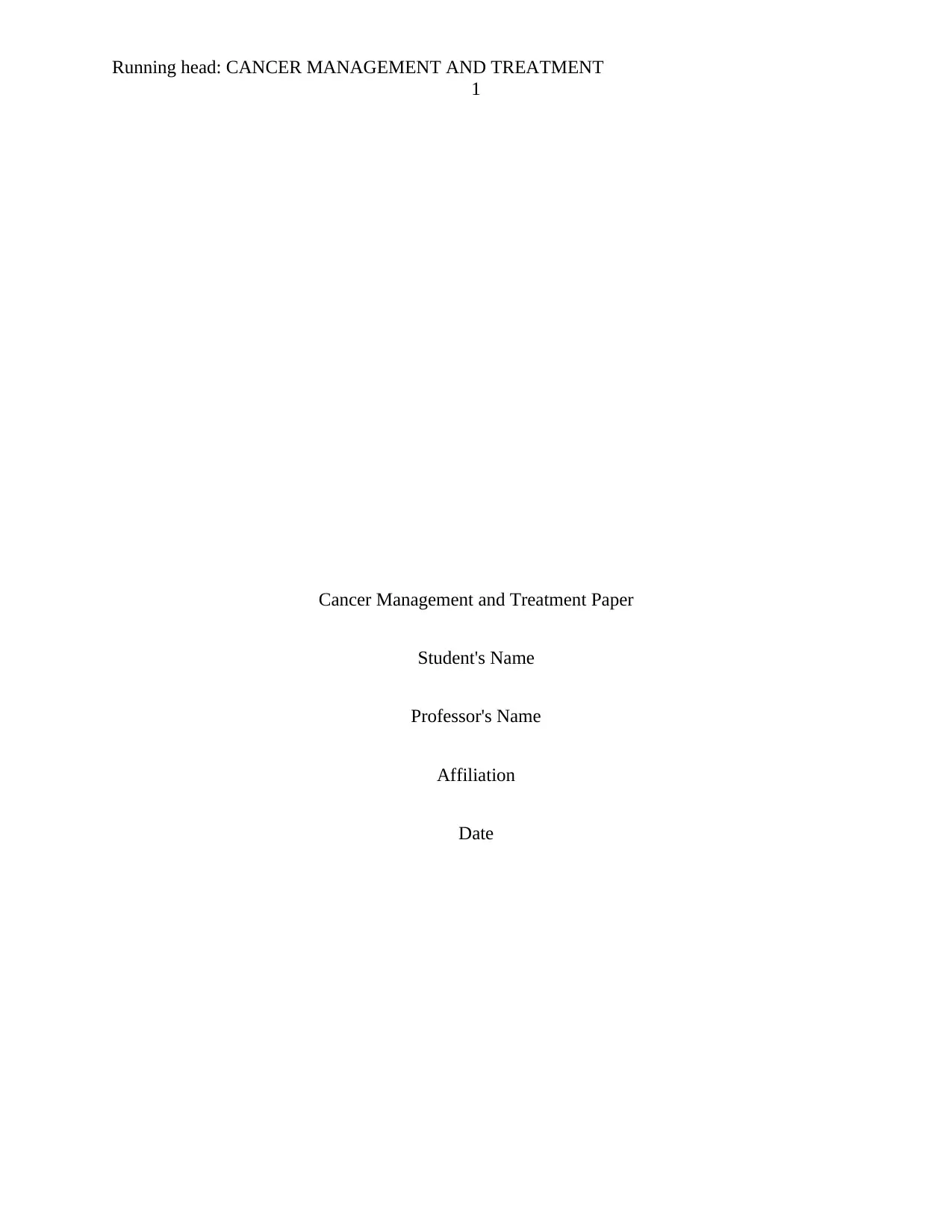
Running head: CANCER MANAGEMENT AND TREATMENT
1
Cancer Management and Treatment Paper
Student's Name
Professor's Name
Affiliation
Date
1
Cancer Management and Treatment Paper
Student's Name
Professor's Name
Affiliation
Date
Paraphrase This Document
Need a fresh take? Get an instant paraphrase of this document with our AI Paraphraser
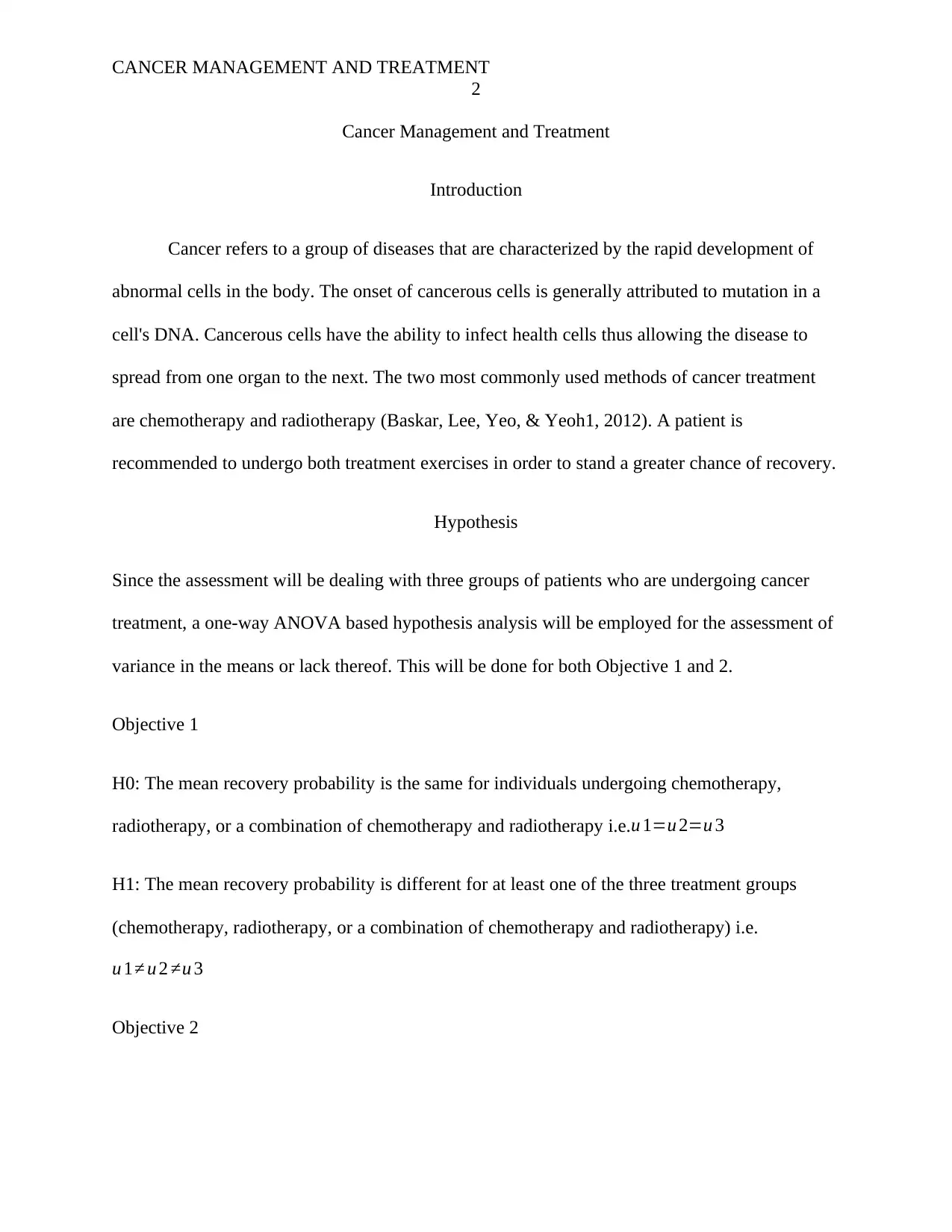
CANCER MANAGEMENT AND TREATMENT
2
Cancer Management and Treatment
Introduction
Cancer refers to a group of diseases that are characterized by the rapid development of
abnormal cells in the body. The onset of cancerous cells is generally attributed to mutation in a
cell's DNA. Cancerous cells have the ability to infect health cells thus allowing the disease to
spread from one organ to the next. The two most commonly used methods of cancer treatment
are chemotherapy and radiotherapy (Baskar, Lee, Yeo, & Yeoh1, 2012). A patient is
recommended to undergo both treatment exercises in order to stand a greater chance of recovery.
Hypothesis
Since the assessment will be dealing with three groups of patients who are undergoing cancer
treatment, a one-way ANOVA based hypothesis analysis will be employed for the assessment of
variance in the means or lack thereof. This will be done for both Objective 1 and 2.
Objective 1
H0: The mean recovery probability is the same for individuals undergoing chemotherapy,
radiotherapy, or a combination of chemotherapy and radiotherapy i.e.u 1=u 2=u 3
H1: The mean recovery probability is different for at least one of the three treatment groups
(chemotherapy, radiotherapy, or a combination of chemotherapy and radiotherapy) i.e.
u 1≠ u 2 ≠u 3
Objective 2
2
Cancer Management and Treatment
Introduction
Cancer refers to a group of diseases that are characterized by the rapid development of
abnormal cells in the body. The onset of cancerous cells is generally attributed to mutation in a
cell's DNA. Cancerous cells have the ability to infect health cells thus allowing the disease to
spread from one organ to the next. The two most commonly used methods of cancer treatment
are chemotherapy and radiotherapy (Baskar, Lee, Yeo, & Yeoh1, 2012). A patient is
recommended to undergo both treatment exercises in order to stand a greater chance of recovery.
Hypothesis
Since the assessment will be dealing with three groups of patients who are undergoing cancer
treatment, a one-way ANOVA based hypothesis analysis will be employed for the assessment of
variance in the means or lack thereof. This will be done for both Objective 1 and 2.
Objective 1
H0: The mean recovery probability is the same for individuals undergoing chemotherapy,
radiotherapy, or a combination of chemotherapy and radiotherapy i.e.u 1=u 2=u 3
H1: The mean recovery probability is different for at least one of the three treatment groups
(chemotherapy, radiotherapy, or a combination of chemotherapy and radiotherapy) i.e.
u 1≠ u 2 ≠u 3
Objective 2
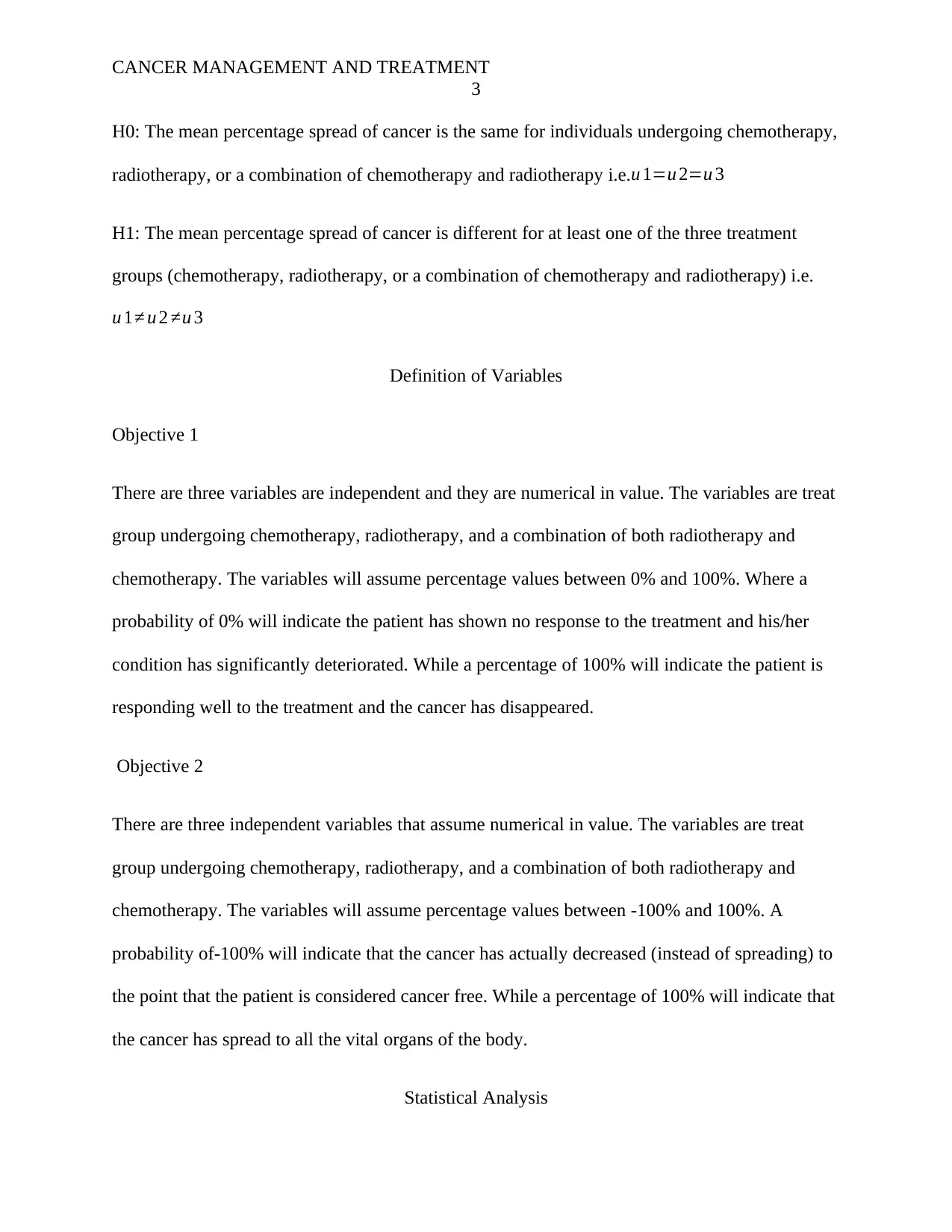
CANCER MANAGEMENT AND TREATMENT
3
H0: The mean percentage spread of cancer is the same for individuals undergoing chemotherapy,
radiotherapy, or a combination of chemotherapy and radiotherapy i.e.u 1=u 2=u 3
H1: The mean percentage spread of cancer is different for at least one of the three treatment
groups (chemotherapy, radiotherapy, or a combination of chemotherapy and radiotherapy) i.e.
u 1≠ u 2 ≠u 3
Definition of Variables
Objective 1
There are three variables are independent and they are numerical in value. The variables are treat
group undergoing chemotherapy, radiotherapy, and a combination of both radiotherapy and
chemotherapy. The variables will assume percentage values between 0% and 100%. Where a
probability of 0% will indicate the patient has shown no response to the treatment and his/her
condition has significantly deteriorated. While a percentage of 100% will indicate the patient is
responding well to the treatment and the cancer has disappeared.
Objective 2
There are three independent variables that assume numerical in value. The variables are treat
group undergoing chemotherapy, radiotherapy, and a combination of both radiotherapy and
chemotherapy. The variables will assume percentage values between -100% and 100%. A
probability of-100% will indicate that the cancer has actually decreased (instead of spreading) to
the point that the patient is considered cancer free. While a percentage of 100% will indicate that
the cancer has spread to all the vital organs of the body.
Statistical Analysis
3
H0: The mean percentage spread of cancer is the same for individuals undergoing chemotherapy,
radiotherapy, or a combination of chemotherapy and radiotherapy i.e.u 1=u 2=u 3
H1: The mean percentage spread of cancer is different for at least one of the three treatment
groups (chemotherapy, radiotherapy, or a combination of chemotherapy and radiotherapy) i.e.
u 1≠ u 2 ≠u 3
Definition of Variables
Objective 1
There are three variables are independent and they are numerical in value. The variables are treat
group undergoing chemotherapy, radiotherapy, and a combination of both radiotherapy and
chemotherapy. The variables will assume percentage values between 0% and 100%. Where a
probability of 0% will indicate the patient has shown no response to the treatment and his/her
condition has significantly deteriorated. While a percentage of 100% will indicate the patient is
responding well to the treatment and the cancer has disappeared.
Objective 2
There are three independent variables that assume numerical in value. The variables are treat
group undergoing chemotherapy, radiotherapy, and a combination of both radiotherapy and
chemotherapy. The variables will assume percentage values between -100% and 100%. A
probability of-100% will indicate that the cancer has actually decreased (instead of spreading) to
the point that the patient is considered cancer free. While a percentage of 100% will indicate that
the cancer has spread to all the vital organs of the body.
Statistical Analysis
You're viewing a preview
Unlock full access by subscribing today!
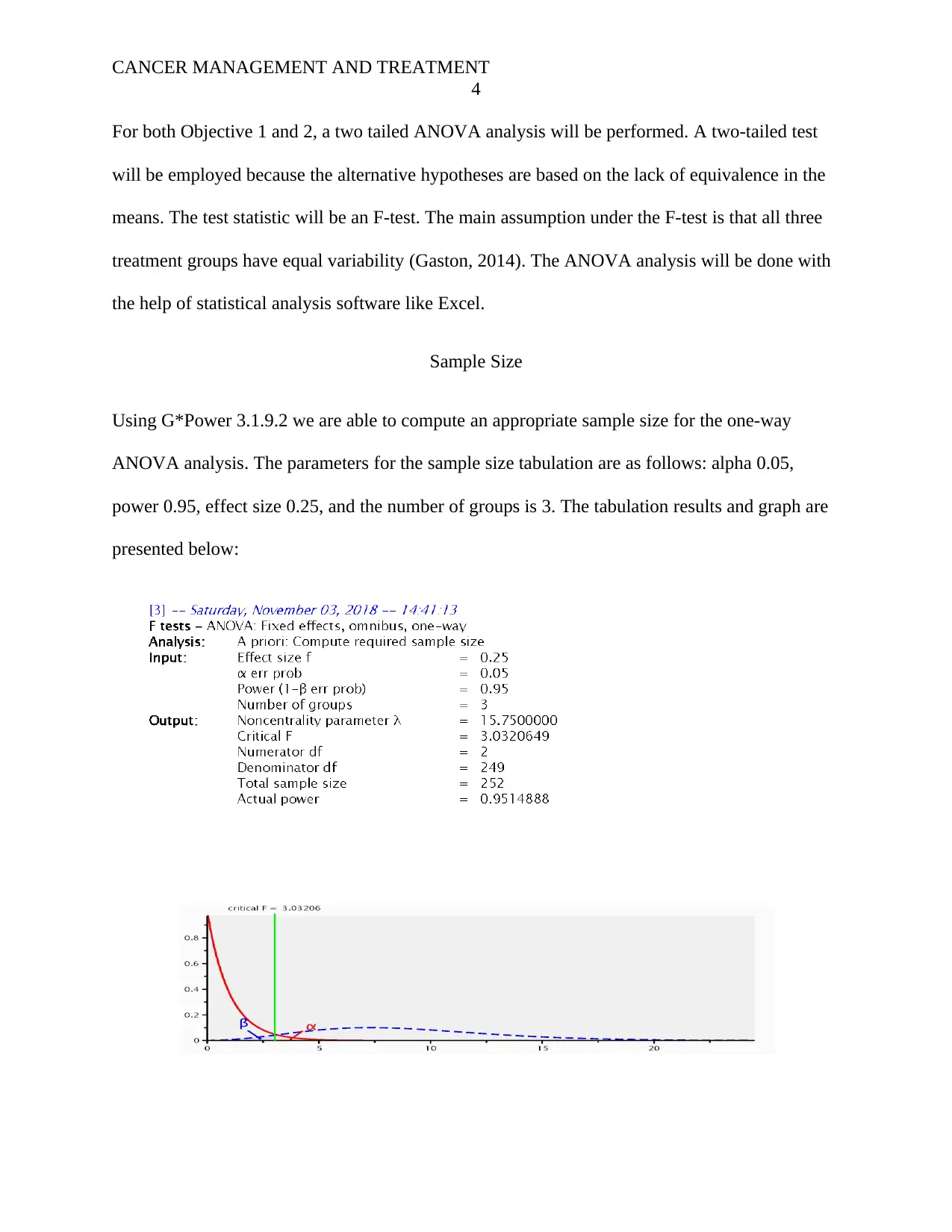
CANCER MANAGEMENT AND TREATMENT
4
For both Objective 1 and 2, a two tailed ANOVA analysis will be performed. A two-tailed test
will be employed because the alternative hypotheses are based on the lack of equivalence in the
means. The test statistic will be an F-test. The main assumption under the F-test is that all three
treatment groups have equal variability (Gaston, 2014). The ANOVA analysis will be done with
the help of statistical analysis software like Excel.
Sample Size
Using G*Power 3.1.9.2 we are able to compute an appropriate sample size for the one-way
ANOVA analysis. The parameters for the sample size tabulation are as follows: alpha 0.05,
power 0.95, effect size 0.25, and the number of groups is 3. The tabulation results and graph are
presented below:
4
For both Objective 1 and 2, a two tailed ANOVA analysis will be performed. A two-tailed test
will be employed because the alternative hypotheses are based on the lack of equivalence in the
means. The test statistic will be an F-test. The main assumption under the F-test is that all three
treatment groups have equal variability (Gaston, 2014). The ANOVA analysis will be done with
the help of statistical analysis software like Excel.
Sample Size
Using G*Power 3.1.9.2 we are able to compute an appropriate sample size for the one-way
ANOVA analysis. The parameters for the sample size tabulation are as follows: alpha 0.05,
power 0.95, effect size 0.25, and the number of groups is 3. The tabulation results and graph are
presented below:
Paraphrase This Document
Need a fresh take? Get an instant paraphrase of this document with our AI Paraphraser
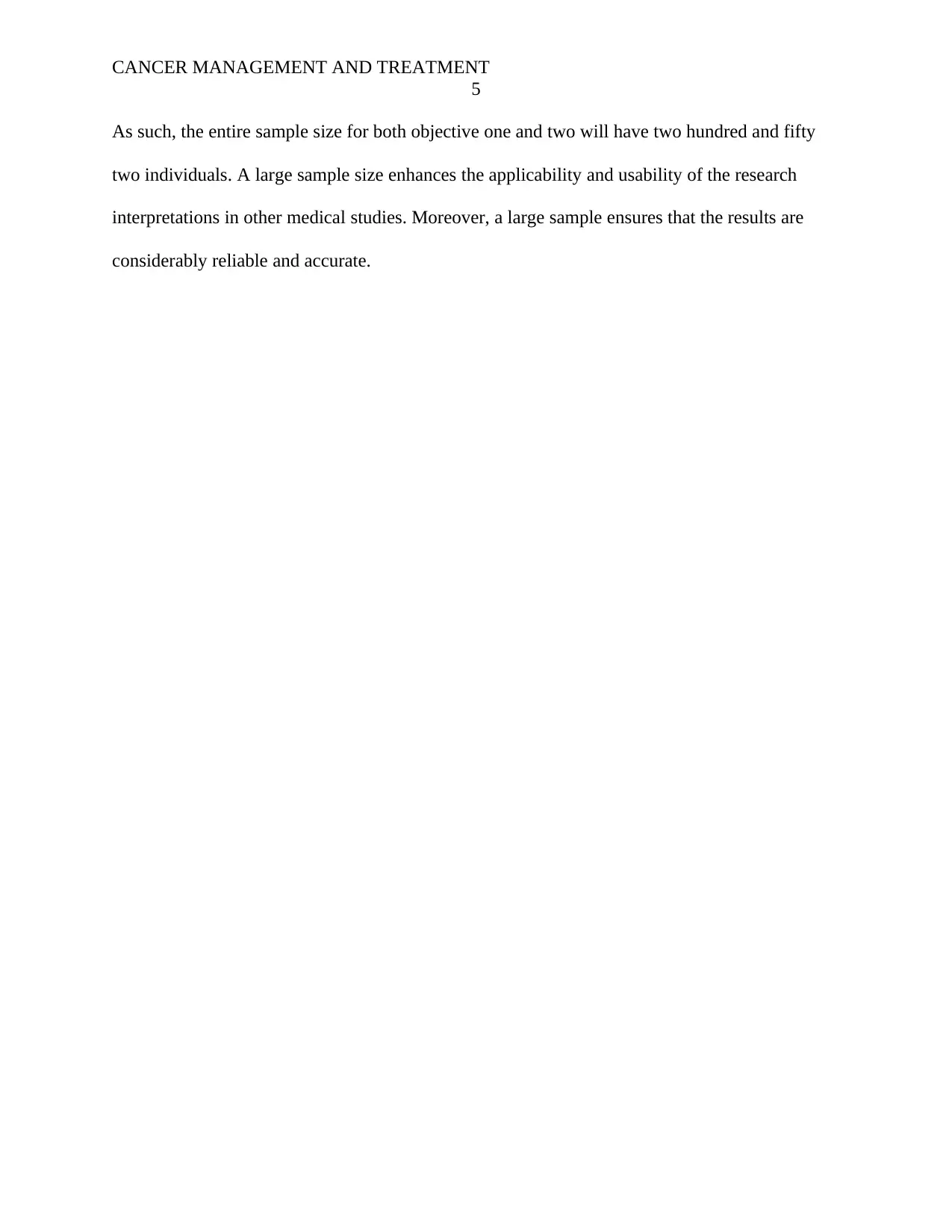
CANCER MANAGEMENT AND TREATMENT
5
As such, the entire sample size for both objective one and two will have two hundred and fifty
two individuals. A large sample size enhances the applicability and usability of the research
interpretations in other medical studies. Moreover, a large sample ensures that the results are
considerably reliable and accurate.
5
As such, the entire sample size for both objective one and two will have two hundred and fifty
two individuals. A large sample size enhances the applicability and usability of the research
interpretations in other medical studies. Moreover, a large sample ensures that the results are
considerably reliable and accurate.
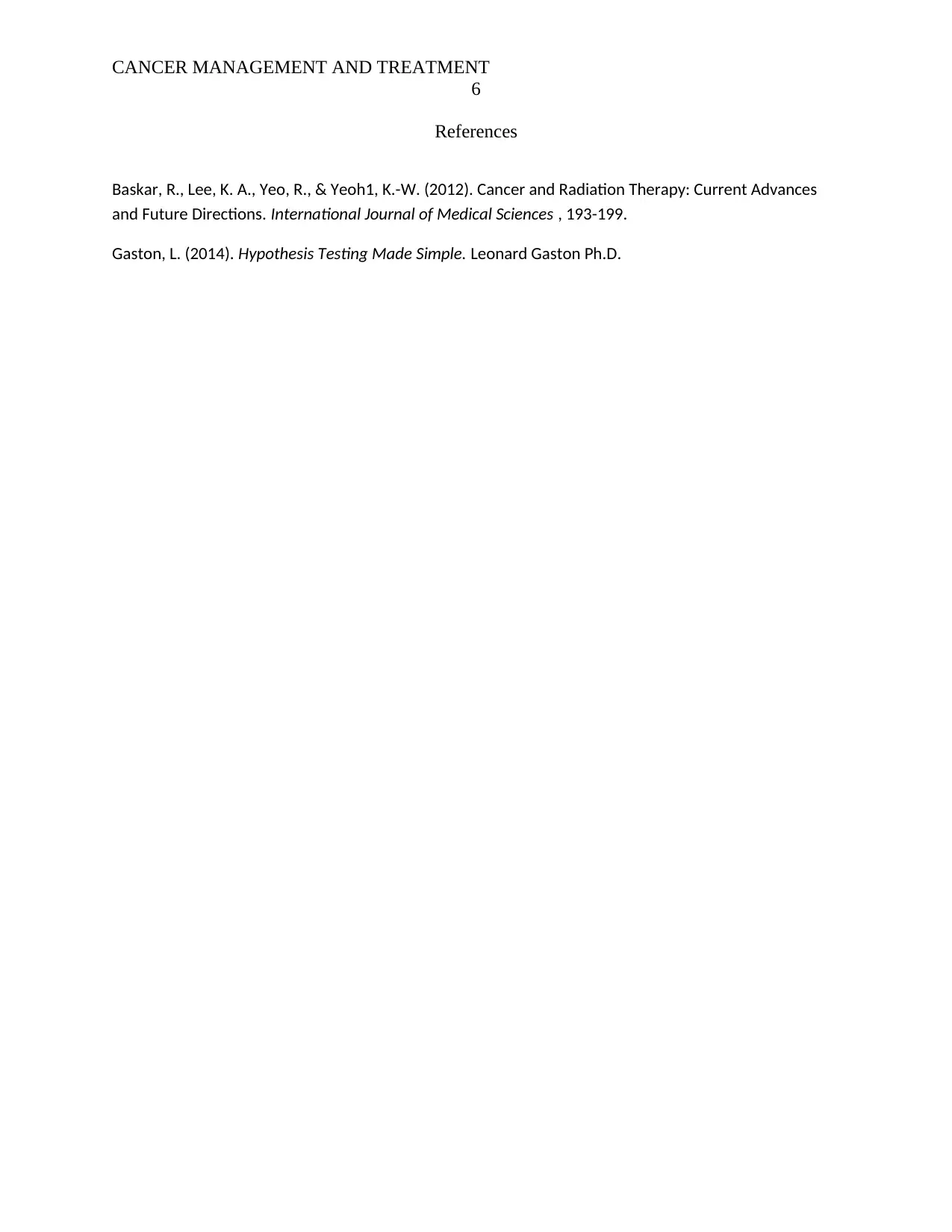
CANCER MANAGEMENT AND TREATMENT
6
References
Baskar, R., Lee, K. A., Yeo, R., & Yeoh1, K.-W. (2012). Cancer and Radiation Therapy: Current Advances
and Future Directions. International Journal of Medical Sciences , 193-199.
Gaston, L. (2014). Hypothesis Testing Made Simple. Leonard Gaston Ph.D.
6
References
Baskar, R., Lee, K. A., Yeo, R., & Yeoh1, K.-W. (2012). Cancer and Radiation Therapy: Current Advances
and Future Directions. International Journal of Medical Sciences , 193-199.
Gaston, L. (2014). Hypothesis Testing Made Simple. Leonard Gaston Ph.D.
You're viewing a preview
Unlock full access by subscribing today!
1 out of 6
Your All-in-One AI-Powered Toolkit for Academic Success.
+13062052269
info@desklib.com
Available 24*7 on WhatsApp / Email
![[object Object]](/_next/static/media/star-bottom.7253800d.svg)
Unlock your academic potential
© 2024 | Zucol Services PVT LTD | All rights reserved.


